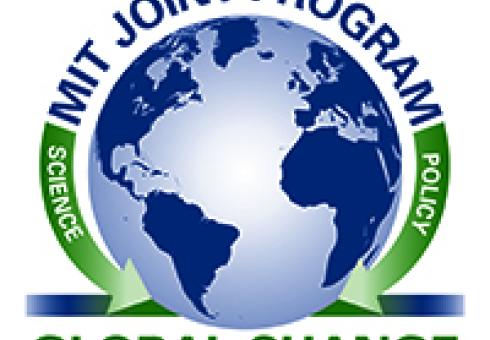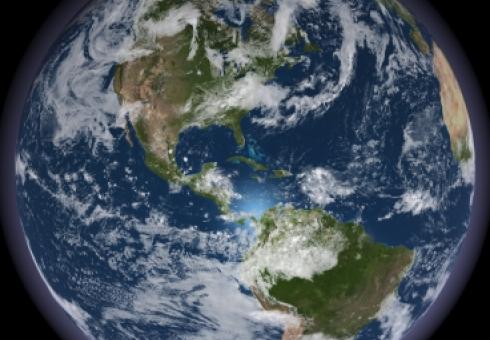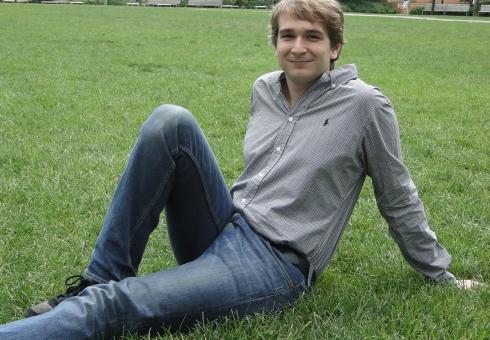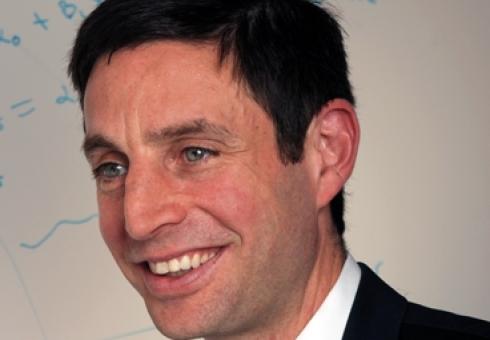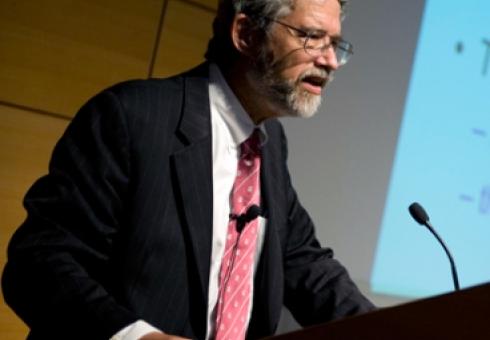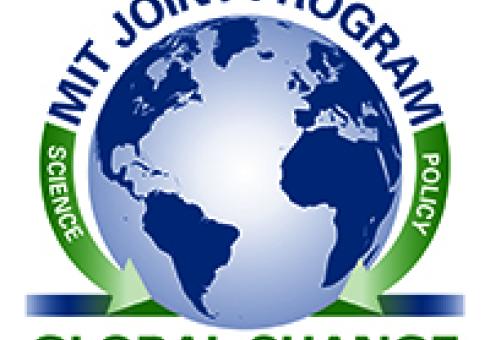News + Media
Joint Program students and researchers speak with the Boston Museum of Science on NOAA's announcement that 2010 was the hottest year on record.
Scientists at the National Oceanic and Atmospheric Administration announced that 2010 was tied for the warmest year on record. Hear some perspectives on this information from researchers at the MIT Joint Program on the Science and Policy of Global Change.
Joint Program report examines discrepancies in climate-change cost estimates
Allison Crimmins, MIT Joint Program on the Science and Policy of Global Change
A recent report from MIT researchers aims to identify why proposals for climate-change legislation often have varying and wildly different cost estimates.
The report, released in October 2010 by the MIT Joint Program on the Science and Policy of Global Change, focuses on two causes for cost-analysis discrepancies: the use of different cost measures; and different assumptions used to determine the amount of emissions reductions required to meet a policy target.
An example of recent discrepancies can be seen in the nine independent cost estimates for the 2009 Waxman-Markey Bill, which would reduce emissions in the U.S. primarily through a cap-and-trade system. In those models, the cost of enacting the policy ranged from $69 to $808 per household in 2020 — a staggering 12-fold difference.
"Divergent estimates of the cost of climate policy can cause confusion among policy makers and the public, but this important study is the first to show how much of the difference is due to researchers asking different questions or measuring different concepts, and how much is due to different assumptions about economic growth, technical change, behavioral responses, and how the model treats each of the many features of climate policy," said Don Fullerton, a professor at the University of Illinois and managing editor of the BE Journal of Economic Analysis & Policy who was not involved in the research.
The report notes that some of the differences in cost estimates can be attributed to modelers using different measures to quantify costs; right now, there is no consistent or conventional way to measure the costs of climate policies. Also, when projecting the costs of legislation, assumptions have to be made on how much emissions will need to be reduced in the future to reach a policy target.
Because policies that address climate change are usually long-term endeavors, small assumptions made from the beginning of legislative implementation can be magnified over the time span of the cost-estimate study. This means that small differences in assumptions can result in large differences in the end.
The broad range of cost estimates of climate legislation in the U.S. can contribute to confusion in policy discussions. Even if the disparities that arise from using different cost measures were eliminated, much of this range in cost estimates would still exist. Some uncertainties may be reduced, for example by defining policy implementation details. But others, like projecting economic activity or the availability of alternative technologies over the long-term, are irreducible. Regardless, the report notes that greater care and transparency is needed when comparing cost-estimate results.
Read more about the report's findings

The way we power our homes and cars and factories is one of the most important choices our society faces. Perhaps it’s the push of climate change, air pollution, resource depletion, and national security. Or maybe it’s the pull of new technologies and newfound energy supplies that may be cheap and clean. Either way, most experts expect that we are heading toward a virtual revolution in the power and energy industries over the next few decades.
But whether we can revolutionize our energy infrastructure—and how, exactly, we would do it—is not simply a question of technology. Economics will play a deciding role in what unfolds. For alternative technologies to be chosen among the mix of energy sources, they must be able to compete in the energy market. The future costs of energy technologies and the ever-changing price of conventional energy sources will determine the success of alternatives over conventional, fossil fuel-powered technologies.
A Realistic Climate Proposal Selected For Judge's Choice Award
A team of students at MIT working at the Joint Program on the Science and Policy of Global Change created a proposal to answer the question: “ What international climate agreement should the world community make?” and submitted it to the Climate CoLab Contest. A group of expert judges chose four finalists and web visitors then voted for their favorite proposal for an international climate agreement. Two winners were chosen: the proposal that received the most votes and the judges' pick.
The Joint Program Students' entry, A Realistic Climate Proposal, was chosen as a winner by the judges!
As a winning team, student representatives briefed the United Nations and U.S. Congress on their proposal. The UN briefing was held on December 2 in New York, with a member and staffers of the United Nations Secretary General's Climate Change Support Team. The U.S. Congress briefing was held on December 7 in Washington, D.C., with staffers of the U.S. House of Representatives Select Committee on Energy Independence and Global Warming.
CONGRATULATIONS to Team Members: Tim Cronin, Arthur Gueneau, Jen Morris, Dan Chavas, and Paul Kishimoto!
Researchers model the effects of competition for global water resources on agriculture
Allison Crimmins, MIT Joint Program on the Science and Policy of Global Change
As the globe’s population increases and people become wealthier, agricultural production will need to likewise increase. But food systems may become more stressed because of a competition for water, according to a new study on various threats to agricultural water supply released by the MIT Joint Program on the Science and Policy of Global Change.
The study found that the biggest threat to future water availability for agriculture comes from environmental flow requirements. These requirements ensure that the appropriate water levels needed for a healthy aquatic ecosystem are maintained. But environmental flow requirements, especially when combined with other competition for water resources, can create geographic hotspots of severe water scarcity.
Already, competition for water comes from demands for energy generation and growing urban populations. As water scarcity increases and river-basin supplies are put to full use, more and more water will be diverted from agricultural use. Added to this is the expected growth in population, which will tax water availability and food supply. Furthermore, the growing population is also getting wealthier, meaning more people will demand services that use more water and will shift to diets that consist of water-intensive products. All of this will lead to greater water demand on a per-capita basis, particularly in developing nations.
The MIT study examines three specific factors that may threaten agricultural water availability in the future. The first factor is increased demand for water in municipal and industrial uses, including for domestic and commercial purposes and for use in manufacturing, energy generation or other industrial activities. The increase in water use in these sectors is driven by rising populations and increasing per capita income, but will vary widely across different countries. The exact relationship between per-capita water use and per-capita GDP often depends on the development path of a particular nation.
For example, developing nations such as India and China will likely experience dramatic increases in water use. As per-capita income rises, the way in which people access water will evolve from traditional methods, such as rainwater catchments and public standpipes, to modern services, such as individual household plumbing. Developed countries, on the other hand, may experience a flattening of water consumption with respect to income. As nations like the U.S. and Switzerland introduce water-efficiency measures, per-capita water use may actually decline.
The second factor the MIT study modeled was environmental flow requirements, which regulate a minimum flow of water to allow for the maintenance of aquatic ecosystem services, including considerations for floodplain maintenance, fish migration and water quality. Imposing water flow minimums, while crucial for some ecosystem demands, may cause the demand for water to exceed supply in river basins within the Middle East, central Asia and southern Europe.
The third factor modeled by the study is the impact of climate change on water availability. Climate change can affect the water available for agricultural use through changes in temperature, precipitation and the magnitude and frequency of extreme events. The combination of these climatic impacts will affect the supply of water — in the form of run-off — in different ways around the world. For example, models predict that run-off will increase in eastern equatorial Africa under a warmer climate, while in southern Africa run-off would decline. Rising temperatures will also increase water demands for domestic uses, including garden and lawn watering, thermoelectric cooling in power plants, and electricity generation to meet increased use of air conditioning.
Researchers modeled the effects these three factors would have on agricultural water availability, assuming increased demands were met by the transfer of water currently used for agriculture. The study found that meeting environmental flow requirements presents the biggest threat to agricultural water availability, with the second-largest threat coming from increased municipal and industrial demands.
In areas with growing populations and income, water demands are projected to increase by more than 200 percent by 2050. When combined, increases in demand for water from municipal and industrial uses and environmental flow requirements cause an 18-percent reduction in the water available for agriculture globally.
Climate change alters the distribution of water supply. Therefore, climate change can increase the threat to agriculture in some areas, such as Africa, Latin America and the Caribbean, and decrease the threat in others, such as North America and Asia.
The effect of competition for water creates dramatic geographical hotspots where water resources available for agricultural purposes are threatened. Such hotspots include northern Africa, India, China, parts of Europe, the western U.S., and eastern Australia — areas that already tend to experience water scarcity. Competition for water may pose significant threats to future food systems in these regions.

Percent of agricultural water threatened under a dry climate change scenario, given 2050 municipal and industrial withdrawals and environmental flow requirements Image: Kenneth Strzepek and Brent Boehlert
Moderator: Richard Samuels
Panelists: Barry Posen
Henry D. Jacoby
Simon Johnson
Peter Dizikes, MIT News Office
As deficit hawks appear poised for victory at the polls, the MIT economics professor presents the case for more spending on infrastructure and R&D.
Government deficit spending has been a contentious issue during this year’s U.S. mid-term election campaigns. Yet some economists believe that additional government spending in certain areas is needed to help spur growth. MIT News asked Michael Greenstone, MIT’s 3M Professor of Environmental Economics, and director of The Hamilton Group, a Washington-based public-policy organization, about America’s spending priorities.
Presidential science adviser calls for increased energy R&D to create jobs and boost business; supports conclusions of MIT nuclear study.
David L. Chandler, MIT News Office
The two toughest challenges the nation faces in terms of energy, according to presidential science adviser John Holdren ’65 SM ’66, are meeting our transportation needs with less oil, and meeting economic aspirations while producing less climate-altering carbon-dioxide emissions. But the good news, he told an MIT audience on Monday, Oct. 25, is that meeting those challenges really can promote significant job creation and business growth...

Presidential science adviser John Holdren ’65 SM ’66
delivers the David J. Rose Lecture in Nuclear Technology at MIT.
...He said he agrees fully with the conclusions of the recently released MIT study on The Future of the Nuclear Fuel Cycle, calling for economic support of the first several new nuclear plants in this country, as well as for increased research on potential new fuel-cycle technologies for the longer run and for long-term spent fuel storage options...
The MIT nuclear studies, he said, “have in my judgment reached all the right conclusions,” and he has been actively circulating those documents in Washington.
Hemispheres will respond to climate change differently, with weaker summer storms in the North, study suggests.
Weather systems in the Southern and Northern hemispheres will respond differently to global warming, according to an MIT atmospheric scientist’s analysis that suggests the warming of the planet will affect the availability of energy to fuel extratropical storms, or large-scale weather systems that occur at Earth’s middle latitudes. The resulting changes will depend on the hemisphere and season, the study found.
More intense storms will occur in the Southern Hemisphere throughout the year, whereas in the Northern Hemisphere, the change in storminess will depend on the season — with more intense storms occurring in the winter and weaker storms in the summer. The responses are different because even though the atmosphere will get warmer and more humid due to global warming, not all of the increased energy of the atmosphere will be available to power extratropical storms. It turns out that the changes in available energy depend on the hemisphere and season, according to the study, published Monday in the Proceedings of the National Academy of Sciences.

